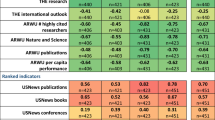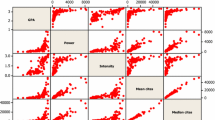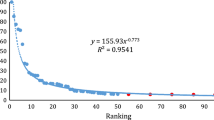Abstract
The QS world university rankings employ six indicators with different weights; namely: academic reputation (40%), Employer reputation (10%), research performance (20% which is basically normalized citations per faculty, Faculty/Student Ratio (20%), International Faculty Ratio (5%) and International Student Ratio (5%). In this ranking system, the research performance is calculated by dividing total normalized citations by the number of full time equivalent faculty. Recently, Abdul-Majeed et al. (2021 proposed a new equation for predicting the research performance of universities, using four variables (number of published papers, number of researchers, total citations, number of non-citesd papers). In the present study, we investigate the influence of using Abdul-Majeed et al. equation on the rank of the top 100 universities of QS ranking. Results have shown that replacing the QS research indicator with that suggested by Abdul-Majeed et al. results in an apparent change in the rank of the 100 universities. The rank of 92 universities has been changed through this new proposal. Furthermore, we modify the Abdul-Majeed et al. equation by including reviewing activity based on information extracted from Publons site. Detailed calculations reveal that most of the top 100 universities have low level of reviewing activity. This modification causes a significant variation (the change reaches 98%) in the rank of the top 100 universities.



Similar content being viewed by others
References
Abdul-Majeed, G., Mahmood, W., & Namer, N. (2021). Measuring research performance of Iraqi universities using Scopus data. Scientometrics, 126(3), 2349–2363. https://doi.org/10.1007/s11192-021-03866-6
Bornmann, L., & Marx, W. (2011). The h index as a research performance indicator. European Science Editing, 37(3), 77–80.
Bornmann, L., Mutz, R., Hug, S. E., & Daniel, H. (2011). A multilevel meta-analysis of studies reporting correlations between the h index and 37 different h index variants. Journal of Informetrics, 5, 346–359. https://doi.org/10.1016/j.joi.2011.01.006
Carbó-Dorca, R. (2010). A monodimensional scientific performance measure: The h index, can be substituted by simple multidimensional descriptors? Journal of Mathematical and Chemistry, 47, 548–550. https://doi.org/10.1007/s10910-009-9573-x
Chi, P. S., & Glänzel, W. (2022). An article-based cross-disciplinary study of reference literature for indicator improvement. Scientometrics. https://doi.org/10.1007/s11192-021-04262-w
Garcia-Perez, M. A. (2009). A multidimensional extension to Hirsch’s h-index. Scientometrics, 81(3), 779–785. https://doi.org/10.1007/s11192-009-2290-1
Glänzel, W. (2006). On the h-index - A mathematical approach to a new measure of publication activity and citation impact. Scientometrics, 67, 315–321. https://doi.org/10.1007/s11192-006-0102-4
Glänzel, W. (2008). H-index concatenation. Scientometrics, 77, 369. https://doi.org/10.1007/s11192-008-2104-x
Hirsch, J. E. (2005). An index to quantify an individual’s scientific research output. Proceedings of the National Academy of Sciences of the United States of America, 102(46), 16569–16572.
Prathap, G. (2010). Is there a place for a mock h-index? Scientometrics, 84, 153–165. https://doi.org/10.1007/s11192-009-0066-2
Schubert, A., & Glänzel, W. (2007). A systematic analysis of Hirsch-type indices for journals. Journal of Informetrics, 1, 179–184. https://doi.org/10.1016/j.joi.2006.12.002
Thelwall, M. (2018). Dimensions: A competitor to Scopus and the Web of Science? Journal of Informetrics, 12, 430–435. https://doi.org/10.1016/j.joi.2018.03.006
Author information
Authors and Affiliations
Corresponding author
Ethics declarations
Conflict of interest
The authors have no relevant financial or non-financial interests to disclose.
Rights and permissions
Springer Nature or its licensor (e.g. a society or other partner) holds exclusive rights to this article under a publishing agreement with the author(s) or other rightsholder(s); author self-archiving of the accepted manuscript version of this article is solely governed by the terms of such publishing agreement and applicable law.
About this article
Cite this article
Abdul-Majeed, G., Saleem, E.A., Smait, D.A. et al. Implementation of a new research indicator to QS ranking system. Scientometrics 128, 1351–1365 (2023). https://doi.org/10.1007/s11192-022-04611-3
Received:
Accepted:
Published:
Issue Date:
DOI: https://doi.org/10.1007/s11192-022-04611-3




